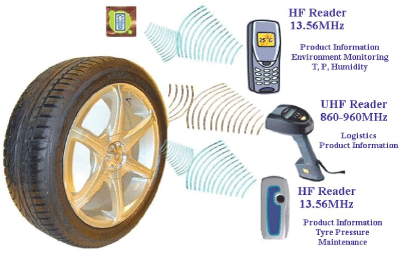by Ovidiu Vermesan, Nadine Pesonen, Cristina Rusu, Aarne Oja, Peter Enoksson and Helge Rustad
IntelliSense RFID project expands the technical and market potential of RFID technology by developing multi-protocol devices with sensing capabilities that are able to sense the environment and communicate at different frequency bands.
Embedded intelligence, or ambient intelligence, is the vision of the future where information will be available to people without their being aware of the surrounding information technology itself. In the ambient intelligent world and in the ubiquitous information society, computing is distributed all around in the environment. Users are mobile and communication is set up between individuals, between individuals and objects and between objects. This communication is obtained via 'invisible intelligent devices' that will tag almost everything in our society in an easy and friendly way. These devices will receive, sense, carry, and distribute context information in our environment.
Radio Frequency IDentification (RFID) is the key technology for local connectivity and an early vehicle for readying these future proactive computing systems.
Nanoelectronics allows the mass production of such new silicon RFID devices with sensing capabilities and this makes massive and low-cost tagging of objects feasible.
In this context, the aim of the IntelliSense RFID project is to develop multi-protocol RFID devices with built-in sensing capabilities, operating at multi-frequency bands. The device can be associated with an object, a person or a location through a simple ID and is capable of measuring and acquiring data about the user's behaviour and his environment (such as temperature T, pressure P, humidity H, and pH), thus creating a smart environment based on surrounding 'invisible intelligent devices'.
It is a two-year project (2006-2007) and is part of the Nordic research programme NORDITE. It involves SINTEF (Norway) as the institute leading the project, VTT (Finland), Chalmers University of Technology (Sweden), and IMEGO AB (Sweden). The NORDITE programme aims at supporting research institutes and universities from Sweden, Norway and Finland to enhance state-of-the art research in the fields of SW radio, wireless sensors, short-range wireless networks and RFID or MEMS utilising RF technology. The programme goal is to stimulate collaboration among national and Nordic countries, create synergism, and consolidate technological and economic development opportunities for companies and industries. These technology development research projects are funded by TEKES (Finland), VINNOVA (Sweden) and the Norwegian Research Council (Norway).

One functional area of great relevance to many supply chain applications is the ability to monitor environmental or status parameters using a RFID device with built-in sensor capabilities. A generic sensor interface is needed in the RFID platform to enable various applications that can be realised by integrating the proper, low-cost sensor element to the RFID platform. The IntelliSense RFID project focuses on developing a generic sensor interface, integrated with the RFID circuitry, for external capacitive sensor elements. At this stage, capacitive sensors will be used to measure temperature, pressure, humidity, and pH.
One of the major issues with large-scale RFID networks is the lack of standardisation across many fronts. This ranges from the different data formats used, via reduced interoperability between RFID readers and tag/transponder devices from different vendors, to interference problems between RFID products from different manufacturers and the different frequency bands used in different countries.
To overcome such problems, the 'global sensing RFID devices' developed in the IntelliSense RFID project are designed to be able to communicate at different frequency bands with different communication protocols. They can thus communicate with the existing infrastructure (ie, existing RFID interrogators) in various environments. Of special importance is the combination of high frequency (HF) 13.56MHz and ultra high frequency (UHF) 860-960MHz RFID standards. Indeed, multi-band tags are needed to penetrate from logistics to mobile phone-based consumer markets. For example, the same dual-band tag can be exploited for logistics, by using the UHF RFID interrogators, and by consumers, to retrieve the content of the device memory by utilising the integrated HF RFID reader in a mobile phone. Applications that can benefit from such a dual-band RFID tag technology include object authentication and information, personalisation, protection against theft, maintenance, and recycling.
The IntelliSense RFID technology platform will address the HF, UHF and microwave (MW) 2.45GHz frequency bands focusing, in the first phase, on the integration of the HF and UHF RFID specific protocols.
The whole infrastructure 'readers-RFID devices' will form the future 'Internet of Things' that will be one of the main element of the 'Ambient Intelligence' and 'Ubiquitous Information' society.
Please contact:
Ovidiu Vermesan, SINTEF ICT, Norway
Tel: +47 22 06 75 06
E-mail: Ovidiu.Vermesan![]() sintef.no
sintef.no










